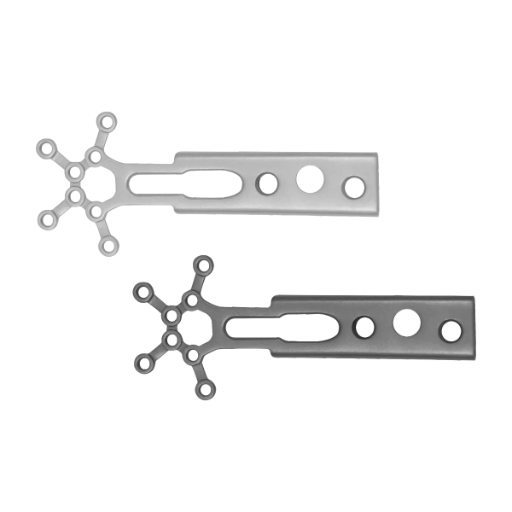E-mail iNfo@virkortho.shop Number +92-300-7477492

Locking Trochanter Stabilizing Plate
High-quality mount for brake rotors
Additional features of Locking Trochanter Stabilizing Plate
Locking Trochanter Stabilization Plate extends the Dynamic Hip Screw Plate and Locking Dynamic Hip Screw Plate constructs to help stabilize the greater trochanter and to facilitate insertion of an anti-rotation screw into the femoral head.
Limits medialization: Provides buttress support to prevent the fracture from medializing and dropping into valgus.
Prevents rotation: 6.5 mm/7.3 mm cannulated screws can be placed through the plate, cranially and parallel to the Dynamic Hip Screw Lag Screw. By putting the anti-rotation screw through the plate, the plate prevents submersion of the screw head into osteopenic bone.
Instead of a cerclage, use locking head screws to achieve an additional proximal internal fixation (cerclage is still possible).
Only one size is required (plate can be cut).
It is easy to bend the plate and adapt it to the individual anatomical conditions.
Plates available in both Titanium and Stainless steel.
Locking Trochanter Stabilizing Plate uses
Locking Trochanter Stabilizing Plate is intended to treat stable and unstable fractures of the proximal femur:
Intertrochanteric
Subtrochanteric
Pertrochanteric
Basilar neck fractures
Locking Trochanter Stabilizing Plate has been designed as an extension to the Dynamic Hip Screw Plate and serves the following functions:
It limits diaphyseal medialisation by fastening onto the greater trochanter.
It enables the insertion of an additional cranial and parallel antirotation screw, which acts as a superolateral tension band. When used, the atirotation screw imposes a slightly more caudal positioning of the screw compared to the standard technique.
It allows for an additional proximal internal fixation of the greater trochanter with locking head screws.
It maintains the dynamization capacity of the Dynamic Hip Screw Plate.
Advantages of angular stability
Locked angle-stable screws can be fixed monocortically, even in soft bone without any risk of screw loosening. Due to the high stability of the screws in the plate, the greater trochanter can be secured as a functional entity without using cerclage wires. Fix the plate over or through the gluteus medius muscle without compressing the bone. As an internal fixator, the plate preserves bone vascularity.
About
Exceptional orthopedic instruments and implants from Pakistan.
Contact
Portfolio
© 2025 All rights reserved.
Location
Quick Link